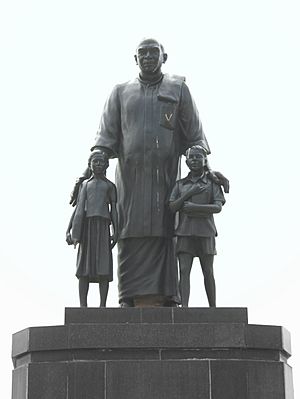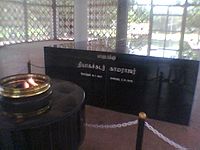K. Kamaraj facts for kids
Quick facts for kids
K. Kamaraj
|
|
|---|---|

K. Kamaraj commemorative stamp
|
|
| 2nd Chief Minister of Madras State | |
| In office 13 April 1954 – 2 October 1963 |
|
| Governor |
|
| Preceded by | C. Rajagopalachari |
| Succeeded by | M. Bhakthavatsalam |
| Constituency | Gudiyatham (1954-1957) and Sattur (1957-1963) |
| Member of Parliament, Lok Sabha | |
| In office 9 January 1969 – 2 October 1975 |
|
| Prime Minister | Indira Gandhi |
| Preceded by | A. Nesamony |
| Succeeded by | Kumari Ananthan |
| Constituency | Nagercoil |
| In office 13 May 1952 – 12 April 1954 |
|
| Prime Minister | Jawaharlal Nehru |
| Preceded by | position established |
| Succeeded by | U. Muthuramalingam Thevar |
| Constituency | Srivilliputhur |
| President of the Indian National Congress (Organisation) | |
| In office 12 November 1969 – 2 October 1975 |
|
| Preceded by | position established |
| Succeeded by | Morarji Desai |
| President of the Indian National Congress | |
| In office 1964–1967 |
|
| Preceded by | Neelam Sanjiva Reddy |
| Succeeded by | S. Nijalingappa |
| President of the Madras Provincial Congress Committee | |
| In office 1946–1952 |
|
| Succeeded by | P. Subbarayan |
| Member of the Madras State Legislative Assembly | |
| In office 6 August 1954 – 28 February 1967 |
|
| Constituency | Gudiyatham (1954-1957) Sattur (1957-1967) |
| Personal details | |
| Born |
Kumaraswami Kamaraj
15 July 1903 Virudhunagar, Madras Presidency, British India (present-day Virudhunagar District, Tamil Nadu, India) |
| Died | 2 October 1975 (aged 72) Madras (present-day Chennai, Tamil Nadu, India) |
| Cause of death | Heart Attack (Myocardial Infarction) |
| Resting place | Perunthalaivar Kamarajar Ninaivagam |
| Political party | Indian National Congress (O) (1969-1975) |
| Other political affiliations |
Indian National Congress (until 1969) |
| Spouse | None |
| Children | None |
| Residences | Kamarajar Illam 1/10, Thyagaraya Nagar, Chennai, Tamil Nadu, India |
| Profession | |
| Awards |
|
| Signature | |
| Nicknames |
|
Kumaraswami Kamaraj (born July 15, 1903 – died October 2, 1975) was an important Indian leader. People knew him as Kamarajar. He fought for India's freedom and later became a politician.
He served as the Chief Minister of Madras State (now Tamil Nadu) from 1954 to 1963. He was also a leader of the Indian National Congress (Organisation). Many called him the "Kingmaker" in Indian politics during the 1960s. This was because he helped choose two Prime Ministers for India.
Kamaraj was known for being simple and honest. He worked hard to improve schools and the lives of poor people in Madras State. He brought free education and started the Midday Meal Scheme for school children. In 1976, he received India's highest civilian award, the Bharat Ratna, after his death.
Contents
Early Life and Education
Kamaraj was born on July 15, 1903, in Virudhunagar, Tamil Nadu. His parents were Kumaraswami and Sivakami Ammal. His birth name was Kamatchi, but it was later changed to Kamarajar.
His father was a merchant. Kamaraj also had a younger sister named Nagammal. He started school in 1907. Sadly, his father died when Kamaraj was only six years old. His mother then had to support the family. Kamaraj left school in 1914 to help his mother.
Joining the Fight for Freedom
As a young boy, Kamaraj worked in his uncle's shop. During this time, he started going to public meetings. He learned about the Indian Home Rule Movement, which wanted India to govern itself.
He read newspapers every day and became very interested in politics. The Jallianwala Bagh massacre in 1919 deeply affected him. He decided to fight for India's freedom from British rule.
Early Political Steps
In 1920, at 18, Kamaraj became active in politics. He joined the Congress party as a full-time worker. In 1921, he organized public meetings in Virudhunagar for Congress leaders. He met Mahatma Gandhi for the first time in Madurai in 1921. Kamaraj then traveled to villages to spread the message of the Congress party.
In 1922, he took part in a protest in Madras. This was part of the Non-cooperation movement, where Indians refused to cooperate with British rule. From 1923 to 1925, Kamaraj joined the Flag Satyagraha protest. In 1927, he led the "Sword Satyagraha" in Madras.
Protests and Prison Terms
Kamaraj was arrested in June 1930 for joining the "Salt Satyagraha". This was a protest against the British salt tax, led by C. Rajagopalachari. He was released early due to the Gandhi-Irwin Pact in 1931.
In 1932, he was arrested again for leading protests in Virudhunagar. These protests were against a law that stopped public meetings. He was sentenced to one year in prison. In 1933, he was wrongly accused in a bomb case, but lawyers proved he was innocent.
At 34, Kamaraj won the Sattur seat in the 1937 election. He became a member of the Assembly. During World War II, he urged people not to give money to the war fund. He was arrested again in 1940 for his speeches against the war fund.
While in jail, he was chosen as a Municipal Councillor for Virudhunagar. But he resigned after his release. He believed he had a bigger duty to the nation. He said, "One should not accept any post to which one could not do full justice."
In 1942, Kamaraj supported the Quit India Movement. This movement called for the British to leave India immediately. He was arrested in August 1942 and stayed in prison for three years. This was his last time in jail. He was imprisoned six times by the British, spending over 3,000 days in total.
In 1966, Kamaraj's house was attacked during a protest by some groups. He was able to escape safely.
Chief Minister of Madras State
On April 13, 1954, Kamaraj became the Chief Minister of Madras Province. He surprised everyone by including leaders who had opposed him in his new government.
Education for All
As Chief Minister, Kamaraj made big changes in education. He stopped a policy that linked education to family jobs. He reopened 6,000 schools that had been closed. He also opened 12,000 more schools.

He wanted every child to go to school. He made education free and required up to the eleventh grade. He started the Midday Meal Scheme to give a free meal to millions of poor school children. He also gave free school uniforms. This helped reduce differences among students based on their background.
Under British rule, only 7% of people could read and write. After Kamaraj's changes, this went up to 37%. He also increased school working days and improved teaching standards. Kamaraj helped establish IIT Madras in 1959.
Boosting Agriculture and Industry
Kamaraj also focused on improving farming and industries. Many new dams and irrigation canals were built. These projects helped bring thousands of acres of land under cultivation. Farmers received loans and equipment to help them grow more crops.
Big industries were started during his time. These included Neyveli Lignite Corporation, BHEL at Trichy, and a railway coach factory in Chennai. Other industries like paper, sugar, and cement also grew.
The Kamaraj Plan
Kamaraj was Chief Minister for three terms. He won elections in 1957 and 1962. He noticed that the Congress party was losing its energy.
On October 2, 1963, he resigned from his Chief Minister post. He suggested that senior Congress leaders should also leave their government jobs. They should instead focus on making the Congress party stronger.
This idea became known as the Kamaraj Plan. It aimed to show that leaders were not just interested in power. They were dedicated to the party's goals. Six government ministers and six Chief Ministers followed his example and resigned.
Prime Minister Jawaharlal Nehru was impressed by Kamaraj's wisdom. He felt Kamaraj's skills were needed more at the national level. So, Kamaraj moved to Delhi and became the President of the Indian National Congress on October 9, 1963.
National Leadership
After Nehru's death in 1964, Kamaraj guided the Congress party through difficult times. As the party president, he chose not to become Prime Minister himself. Instead, he helped two other leaders become Prime Minister. He supported Lal Bahadur Shastri in 1964 and Indira Gandhi in 1966. This is why he was called the "kingmaker."
In 1969, the Congress party split. Kamaraj became the leader of the Indian National Congress (Organisation) (INC(O)) in Tamil Nadu. He remained its leader until his death in 1975.
Personal Life and Values
Kamaraj never married. He lived a very simple life. When the municipality offered a direct water connection to his home, he refused it. He did not want any special treatment.
He also refused extra security as Chief Minister. He traveled with just one police car. He did not own any property. When he died, he had only 130 rupees, two pairs of sandals, four shirts, four dhotis, and a few books. He was never tempted by power or wealth.
Death and Legacy
Kamaraj died at his home on October 2, 1975. This was the same day he had resigned as Chief Minister 12 years earlier. He was 72 years old and passed away in his sleep from a heart attack.
Kamaraj was honored with India's highest civilian award, the Bharat Ratna, in 1976. This award was given to him after his death. Many places are named after him to remember his contributions:
- The domestic terminal of the Chennai airport is called "Kamaraj Terminal."
- Marina beach road in Chennai is now "Kamarajar Salai."
- Roads in Bengaluru and New Delhi are also named after him.
- Madurai Kamaraj University is named in his honor.
- In 2003, the Indian government released a special coin on his birthday.
Popular Culture
In 2004, a Tamil film called Kamaraj was made about his life. An English version of the film was released on DVD in 2007.
Images for kids



